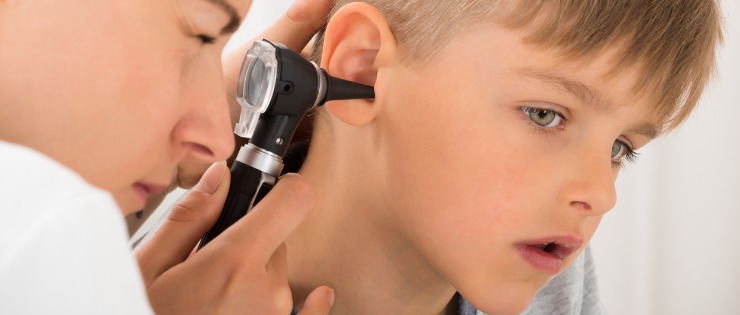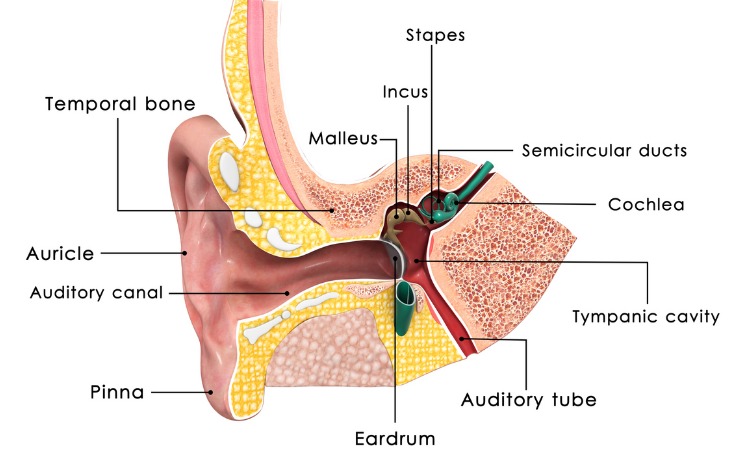
Glue ear is a common ear condition that can strike at any age, but it’s more common in children than adults. Usually glue ear clears up on its own with time. In some cases it persists and requires treatment to avoid permanent hearing loss.
Knowing the symptoms can reduce the chance of glue ear going undiagnosed and potentially causing serious health problems in adults and children.
What is Glue Ear?
Glue ear occurs when the middle ear fills with thick and sticky fluid, like glue. Because the middle ear is located just behind the eardrum, glue ear can cause hearing difficulties and other serious complications.
It’s a very common condition - around eight in 10 children will have had glue ear at least once by the age of 10.
A doctor can diagnose glue ear with a visual check using an otoscope. An audiologist may perform a test called a tympanometry to evaluate if the eardrum can move. If there is fluid in the middle ear, the eardrum won’t move. A hearing test can also check if there is any temporary or permanent hearing loss.

How Long Does Glue Ear Last?
Glue ear can take weeks or months to clear on its own. A GP should monitor the ear to check the glue ear has cleared.
Symptoms of Glue Ear
Sometimes glue ear can go undiagnosed because there are no obvious signs. In other cases, the signs and symptoms of glue ear are obvious. Parents should be on the lookout for:
· Hearing problems
· Ringing or buzzing sounds in the ear
· Balance problems
· Pressure or pain in the ear
· Irritability
· Difficulty sleeping
Signs of hearing problems include a child talking too loudly, having difficulty hearing others speak and asking people to repeat themselves. They may turn up the volume on electronic devices, not be able to hear noises in the distance and not do as well at school.
The thick liquid in glue ear can make it difficult for a child to hear because the fluid stops the eardrum and middle ear bones from vibrating.

Symptoms of Glue Ear in Adults
The symptoms of glue ear in adults are like those in children. An adult may realise their hearing has decreased and they feel as though there is a blockage or pressure. The discomfort in the ear can cause overall tiredness.
What Causes Fluid in the Ear in Adults?
Excess fluid and glue ear can occur after a cold or the flu virus irritates the ear. Seasonal and year-round allergies can cause excess fluid. Ear infections can occur due to smoking or being around second hand smoke.
How Do You Treat Glue Ear?
There’s no medication for glue ear, but if an ear infection is present, a GP may prescribe antibiotics to help clear the fluid. A follow-up hearing test can check that any hearing loss has returned to normal after the glue ear has cleared. If the hearing is still a problem or glue ear returns, a GP may recommend a visit to an Ear Nose and Throat (ENT) specialist to investigate if they need grommets.
Does Glue Ear Go Away on Its Own?
Yes, glue ear will often clear on its own. There is no effective medication for glue ear so a doctor will often take a ‘watch and wait approach’ to see if the fluid goes away within three months. If an ear infection is present, antibiotics may be prescribed to help clear the fluid. If glue ear persists or returns, a GP may recommend a visit to an Ear Nose and Throat (ENT) specialist.
Treatment for Ear Infections
Middle ear infections only require antibiotics if a bacterial infection is present. Decongestants, antihistamines, or nasal steroids may also help with treating the infection. You can also use pain relief like paracetamol or ibuprofen to treat earaches. If symptoms of middle ear infections continue after 48 to 72 hours, it is important to see a doctor because it could cause permanent hearing loss, infection in other parts of the head and even paralysis of facial nerves.
Severe Cases May Need Referral to a Specialist
GPs treat most cases, but early referral to a specialist for glue ear is sometimes needed if:
· The patient experienced hearing loss before glue ear developed
· Glue ear has already caused learning or development delays
· The patient is already diagnosed with Down’s syndrome
· The patient is already diagnosed a cleft palate
It is less likely that glue ear will resolve on its own in a patient with Down’s syndrome or cleft palate as they often have smaller Eustachian tubes that don’t function as well.
Investigating the Back of the Nose
When an adult has glue ear, the doctor may assess the area at the back of the nose (where the Eustachian tube drains the middle ear space and enters the nasal cavity) more than in a child with glue ear. Because single-sided glue ear is rare in adults, a doctor needs to ensure there is no residual adenoid tissue or a tumour at the back of the nose causing the glue ear.
Causes

The back of the nose and middle ear is connected by the Eustachian tube which opens only when we swallow or yawn. While the tube is open, air enters the middle ear and excess liquid empties. When a person is suffering from a common cold or allergic rhinitis (nasal allergy), the Eustachian tube may become swollen and blocked. When the fluid doesn’t empty, it accumulates and thickens until it is the consistency of glue, making it susceptible to infections.
Risk Factors
There are several factors that make children more susceptible to glue ear. Children under the age of two are most at risk of glue ear because their Eustachian tubes are smaller and more level than in adults. Five out of six children will develop an ear infection by their third birthday which has the potential to become glue ear.
Young children also have a developing immune system so they aren’t able to fight off infection like the adult immune system. Boys are more susceptible to glue ear. Winter is the most common time of the year for glue ear.
Some common risk factors include:
- Babies that drink milk from a bottle, particularly those that go to bed with one, are more susceptible to glue-ear. Milk can enter the Eustachian tube if a child is lying down with a bottle of milk.
- Using a dummy is also linked to glue ear. A Dutch study of 500 children revealed the risk of recurrent ear infections was almost double in young children who used a dummy.
- A cleft palate can make glue ear more likely because the muscles that open the tube rarely work as they should.
- Poor air quality, particularly when parents or guardians smoke, can make children more susceptible to glue ear.
- Being in childcare where there is higher exposure to germs can make some children more at risk of colds and ear infections then glue ear compared to those children who spend most of the week at home.
- Children who suffer from seasonal or year-round allergies are more likely to suffer ear infections and glue ear.
Precursors to Glue Ear
While glue ear isn’t an infection, it often follows an ear infection or a cold. If there is no treatment for an ear infection and the fluid builds in the middle ear, glue ear can result.
Ear Infections
There are three main types of ear infections with a range of symptoms.
· Acute otitis media (AOM) is the most common ear infection. The middle ear is infected and swollen trapping fluid behind the eardrum. The fluid build-up may cause an earache and sometimes a fever.
· Otitis media with effusion (OME) can occur after an ear infection when fluid stays trapped behind the eardrum. Unlike AOM, there are often no symptoms. A doctor will need to check if there is any fluid behind the eardrum to know if someone has OME.
· Chronic otitis media with effusion (COME) occurs when fluid stays in the middle ear for some time or returns for months or years, even though there is no infection. New infections are difficult to fight. While not usually painful, COME can be accompanied by eardrum (tympanic membrane) perforation and hearing loss.
Potential for Hearing Loss
Glue ear and ear infections can lead to temporary or permanent hearing loss. Long periods of hearing problems early in a child’s life can affect their speech development, communication skills, reading and spelling which impacts their school grades. They may need temporary hearing aids to assist with hearing loss.
Can Glue Ear Cause Permanent Deafness?
Glue ear that persists for more than a few months can lead to temporary hearing loss. While it’s not common, glue ear can lead to permanent hearing loss if glue ear or ear infections don’t clear. If symptoms don’t improve within a few months, a doctor may prescribe grommets to open the middle ear and reduce fluid build-up.
While the symptoms of glue ear in adults are like children, there are fewer side effects of hearing loss in adults. Hearing loss in adults is less likely to affect speech skills like it does in children who are still developing their language and communication skills.
Speech Therapy
Speech therapy may be required if glue ear has impacted a child’s developmental milestones. A child with mild hearing loss may not hear certain sounds in the English language such as “s”, “to”, “sh”, “f”, “th”. They may not follow directions and have trouble building their vocabulary. Their speech may be hard to understand because they don’t use some sounds.
Swimming and Flying with Glue Ear

Glue ear and swimming isn’t usually a problem unless there is an ear infection. A child with an outer ear infection should avoid swimming for one week so the infection can clear.
Glue ear and flying isn’t a problem in most cases but there may be some discomfort with pressure changes if the Eustachian tube isn’t functioning. Decongestant sprays, auto-inflation and pressure regulating ear plugs can help. In rare cases, inner ear damage can occur with pressure changes. If you are concerned about you or your child flying with glue ear, check with your doctor.
Treating Recurring Ear Infections with Grommets
Grommets are tiny tubes inserted into the eardrum during an operation under general anaesthetic. They are the main treatment method for recurring ear infections and excess fluid in the ear. In theatre, the surgeon suctions the fluid out and cuts a tiny hole cut in the ear drum for inserting the tube.
The grommet tube opens the middle ear to allow more air in to help clear the fluid. The small ear bones and ear drum can then move more and hearing improvements should be immediate. A hearing test will confirm the hearing has improved.
Keeping Ears Dry with Grommets
It is important to keep water out of a child’s ears while they have grommets and until the eardrum is completely healed. No swimming for one week after the operation and then no diving or jumping in water. Water from pools, spas, dams, rivers, lakes and their bath is dirty and care should be taken to keep water out of the ears.
Use ear plugs such as cotton wool with Vaseline, Blu-tac, silicone ear putty, or custom made or shop bought plastic ear plugs. Ear plugs can be held in place with a swimming cap or ear wrap band. A shower can be an easier option than a bath when washing a child’s hair. If water enters the ear with grommets, check there is no fluid discharge from the ear in the days and weeks following and, if so, see your doctor. If an infection occurs a GP may prescribe antibiotic medicine.
Regular Appointments to Check Grommets
A child with grommets may have regular checks to confirm the grommets are still in place and haven’t fallen out. Grommets usually last six to 12 months before falling out and the hole in the eardrum heals soon after. In very rare cases the hole in the eardrum doesn’t close after the tube comes out. Some children may need grommets more than once if the fluid returns.
Grommets may be known by different names depending on their shape and size.
Autoinflation
For children over the age of three and adults, a GP may recommend trying autoinflation to help with glue ear. This at home treatment can avoid the need for grommets in children with hearing loss.
Autoinflation involves blowing up a balloon-type device with each nostril to raise the intranasal pressure and exhaling against a closed airway. During deflation of the balloon, air is forced up the nose and the child swallows, called the Politzer manoeuvre. Completed two to three times per day, the nasal balloon can avoid the need for grommets. If it is too difficult to teach a young child to swallow during deflation, there are still benefits in getting them to inflate the balloon with each nostril.
Surgery for Adenoidectomy
While rare, a person with chronic glue ear may require an adenoidectomy because the bacteria passing through the nose and mouth is trapped in the adenoids causing infection. Adenoidectomy surgery involves removing the adenoid glands behind the nose and connected to the base of the Eustachian tubes. The glands can contribute to fluid build-up so removing them may stop ear infections. Grommets are usually inserted as well to help keep the eardrum open and allow for the fluid to drain away.
Ongoing Management for Glue Ear
Once you or your child has had glue ear, you are more susceptible to recurrences. See your doctor if you think there is an ear infection, glue ear or fluid build-up in the ear to ensure its impact on hearing is minimised.